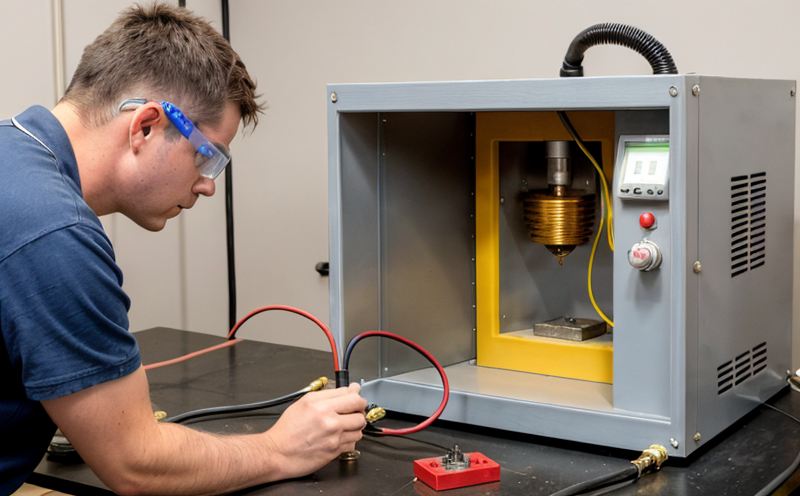ASTM A596 Magnetic Hysteresis Properties of Electrical Steel
The ASTM A596 standard provides a method for determining the magnetic hysteresis properties of electrical steel. This test is critical in ensuring that materials used in transformers, motors, and other electromagnetic devices meet stringent performance standards.
Electrical steel is characterized by its high magnetic permeability and low loss characteristics, which are essential for efficient operation in power conversion applications. The hysteresis loop, a graphical representation of the relationship between magnetic field strength (H) and flux density (B), provides insight into these properties. By measuring the area enclosed within this loop, one can quantify energy losses due to hysteresis.
The test procedure outlined in ASTM A596 involves subjecting samples of electrical steel to cyclic magnetic fields under controlled conditions. Specimens are typically rectangular plates with dimensions specified by the standard. Prior to testing, specimens must undergo appropriate preparation steps such as cleaning and conditioning to ensure accurate results.
Key parameters include frequency of applied field cycles, amplitude, and temperature at which tests are conducted. These factors influence hysteresis loss values significantly; therefore, precise control over experimental variables is crucial for reproducible data.
Upon completion of testing, the resulting magnetic hysteresis curves provide valuable information about the material's coercivity (Hc), saturation magnetization (Bs), and remanence magnetization (Br). These values reflect important aspects of electrical steel's magnetic behavior under varying conditions. Understanding these properties helps manufacturers select optimal materials for specific applications based on desired performance characteristics.
For instance, lower Hc indicates easier switching between polar states, while higher Bs corresponds to greater stored energy per unit volume. Both parameters play key roles in optimizing design choices related to power efficiency and size optimization within electrical systems.
The ASTM A596 method also specifies criteria for acceptable hysteresis loss values depending on the type of application intended. Compliance with these limits ensures that materials perform reliably across various operating scenarios without excessive energy waste.
| Application | Acceptable Hysteresis Loss (W/kg) |
|---|---|
| Transformers operating at low frequencies | <0.3 W/kg |
| Motors with medium frequency drives | <0.5 W/kg |
| High-frequency power converters | <1.0 W/kg |
In summary, ASTM A596 offers a robust framework for evaluating magnetic hysteresis properties of electrical steel, enabling manufacturers to produce high-performance materials tailored specifically for demanding electromagnetic applications.
Benefits
- Precise measurement of energy losses due to hysteresis
- Aids in selecting optimal materials for specific applications
- Ensures compliance with industry standards and specifications
- Supports quality control and process improvement initiatives
The ability to accurately measure magnetic hysteresis properties allows companies involved in the design, production, and quality assurance of electrical components to maintain consistent product performance. By adhering to rigorous testing protocols like those prescribed by ASTM A596, organizations can enhance their reputation for delivering reliable and efficient solutions.
Industry Applications
- Transformers used in power distribution networks
- Motors integrated into industrial machinery
- Switching power supplies found in consumer electronics
- Induction cooktops and other domestic appliances requiring electromagnetic heating elements
The magnetic hysteresis properties evaluated via ASTM A596 are particularly important for optimizing the efficiency of these devices. For example, reducing hysteresis losses can lead to more compact designs with reduced heat generation—a significant advantage in high-power systems where thermal management becomes a challenge.
| Application | Hysteresis Loss Limit (W/kg) |
|---|---|
| Switching power supplies in smartphones | <0.1 W/kg |
| High-efficiency induction motors | <0.25 W/kg |
| Transformer cores in large substations | <0.15 W/kg |
Incorporating ASTM A596 into the development process allows manufacturers to meet these stringent requirements while ensuring their products remain competitive in terms of cost, size, and performance.
Why Choose This Test
- Predictive capability for long-term reliability
- Standardized procedure ensuring reproducibility across laboratories
- Comprehensive evaluation of magnetic properties under controlled conditions
- Affordability compared to other specialized testing methods
The ASTM A596 test offers several advantages over alternative approaches when assessing the magnetic hysteresis properties of electrical steel. Its standardized nature guarantees consistent results regardless of who conducts the experiment, making it easier for researchers and engineers to compare findings.
Moreover, this method provides comprehensive insights into multiple facets of a material's magnetic behavior beyond just hysteresis loss alone. This holistic approach enables more informed decision-making during product design stages.





